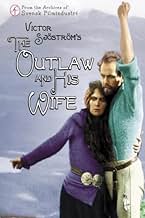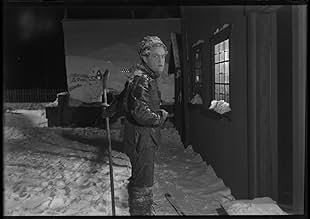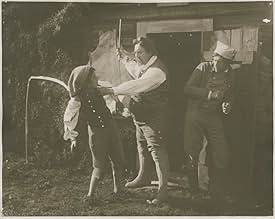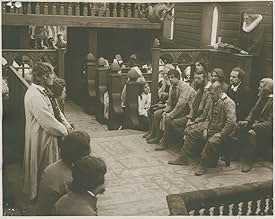AVALIAÇÃO DA IMDb
7,2/10
2,2 mil
SUA AVALIAÇÃO
Adicionar um enredo no seu idiomaEjvind and his family are in need of food. So Ejvind seeks help from the rich priest next door. He refuses to help. Ejvind then steals a sheep from the priest, he is caught. But he escapes f... Ler tudoEjvind and his family are in need of food. So Ejvind seeks help from the rich priest next door. He refuses to help. Ejvind then steals a sheep from the priest, he is caught. But he escapes from prison, and becomes an outlaw.Ejvind and his family are in need of food. So Ejvind seeks help from the rich priest next door. He refuses to help. Ejvind then steals a sheep from the priest, he is caught. But he escapes from prison, and becomes an outlaw.
- Direção
- Roteiristas
- Artistas
Walerie Alexandrow-Höök
- Berg-Ejvinds och Hallas dotter Tota
- (as Walerie Alexandrow)
- Direção
- Roteiristas
- Elenco e equipe completos
- Produção, bilheteria e muito mais no IMDbPro
Avaliações em destaque
I have waited for years to see this film and finally caught it on Youtube - in excellent condition. It was definitely worth the wait! The film was made in 1918, a time when most cinema consisted of small segments of celluloid patched together with the standard melodramatic or comedic situations, clumsily filmed indoors on make-shift sets. This is absolutely nothing of the kind although it took Hollywood what seemed an eternity to figure out that a movie could, indeed, be shot out in the open with great success. Several reviewers have mentioned some sort of connection with early Westerns made by directors of little artistic talent and less scope. Actually, this film has nothing whatsoever to deal with standard plots with famous actors. The plot is extremely simple, as it should be in this case, and all - virtually all - of the over-the-board overacting and the theatrical motions and over-emotions suppressed, with natural gestures replacing them in natural settings...and what beautiful settings they are! No, there aren't any tied-together happy ends around and little to titillate the audience, villains with mustaches or any of the standard American clichés here. The film is Scandinavian, filmed and acted by Scandinavians, shot in North Sweden far, far away from the ole corral. I don't know how well the director, Victor Sjostrom, was acquainted with American cinema at the time - there wasn't really much of anything of much value going except from Griffith and one or two others, but the film borrows nothing and invents everything for its own uses. The cinema up there created a universe of its own, albeit a harsh one. Bergman would follow fifty years later. This was a welcome hour or so spent in the company of people who made some astoundingly good films and this is certainly one of them.
Curtis Stotlar
Curtis Stotlar
Natural surroundings heighten a movie director's ability to examine his characters' identities. The first film in cinema to introduce soaring landscapes and weather elements for the purpose of exploring the actors' interior personalities is Swedish director Victor Sjostrom's January 1918 "The Outlaw and His Wife."
Based on the true story of a mid-1700 criminal escaping incarceration with his wife into the mountains of Iceland, "The Outlaw and His Wife" uses the stunning scenery of northern Sweden to reflect nature's impact on human behavior, especially displayed in the second half of the movie.
Sjostrom and Edith Erastoff appeared in the director's earlier "The Man There Was," and began a relationship despite Erastoff marriage status. In fact, Edith was pregnant with Sjostrom's child when filming "The Outlaw and His Wife." She delivered a girl, Guje Lagerwall, who lived to be 100, soon after the January premier. Sjostrom and Erastoff eventually married in 1922 after she secured a divorce from her first husband.
Sjostrom worked well with cinematographer Julius Jaenzon, who lends a surreal tone to this highly visual film. He uses the sun frequently to backlight the actors, and often overexposes the film to portray them in a fairytale-like glow. Jaenzon also silhouettes his on-camera personalities against huge backdrops to emphasize how puny people and their problems are in relation to the overall scheme of God's great work in presenting earth's majesty.
Besides man's co-existing with a sometimes turbulent nature, Sjostrom shows the psychological mechanics within a human relationship, especially reflected memorably in the sequence where Erastoff throws the couple's baby over the cliff. Such stress in hiding from the law in an unforgiving environment casts a light on the breaking point of the human condition in such circumstances.
Today's directors such as Terrance Malick, known for his photographic expertise, studied "The Outlaw and His Wife" for its natural elements incorporated into their characters' behavior and plot motivations. Sjostrom's film played a huge influence on later visually-stunning motion pictures using nature's varied landscapes.
Based on the true story of a mid-1700 criminal escaping incarceration with his wife into the mountains of Iceland, "The Outlaw and His Wife" uses the stunning scenery of northern Sweden to reflect nature's impact on human behavior, especially displayed in the second half of the movie.
Sjostrom and Edith Erastoff appeared in the director's earlier "The Man There Was," and began a relationship despite Erastoff marriage status. In fact, Edith was pregnant with Sjostrom's child when filming "The Outlaw and His Wife." She delivered a girl, Guje Lagerwall, who lived to be 100, soon after the January premier. Sjostrom and Erastoff eventually married in 1922 after she secured a divorce from her first husband.
Sjostrom worked well with cinematographer Julius Jaenzon, who lends a surreal tone to this highly visual film. He uses the sun frequently to backlight the actors, and often overexposes the film to portray them in a fairytale-like glow. Jaenzon also silhouettes his on-camera personalities against huge backdrops to emphasize how puny people and their problems are in relation to the overall scheme of God's great work in presenting earth's majesty.
Besides man's co-existing with a sometimes turbulent nature, Sjostrom shows the psychological mechanics within a human relationship, especially reflected memorably in the sequence where Erastoff throws the couple's baby over the cliff. Such stress in hiding from the law in an unforgiving environment casts a light on the breaking point of the human condition in such circumstances.
Today's directors such as Terrance Malick, known for his photographic expertise, studied "The Outlaw and His Wife" for its natural elements incorporated into their characters' behavior and plot motivations. Sjostrom's film played a huge influence on later visually-stunning motion pictures using nature's varied landscapes.
(1918) The Outlaw and His Wife/ Berg-Ejvind och hans hustru
SILENT DRAMA
Co-written, directed and starring Victor Sjöström, he plays an unknown drifter, Kari (Victor Sjöström) looking for work and ends up working at a farm, owned by Halla (Edith Erastoff). And as they begin to fall in love, it is then his past begins to catch up with him that his name is not Kari, but is really Eyvind suspected of escaping from prison. Adapted from the play "Eyvind of the Hills" by Jóhann Sigurjónsson.
A silent Swedish film that is reminiscent of a serious love story that has a complicated situation, that can be used as a basis for movies that come after it.
Co-written, directed and starring Victor Sjöström, he plays an unknown drifter, Kari (Victor Sjöström) looking for work and ends up working at a farm, owned by Halla (Edith Erastoff). And as they begin to fall in love, it is then his past begins to catch up with him that his name is not Kari, but is really Eyvind suspected of escaping from prison. Adapted from the play "Eyvind of the Hills" by Jóhann Sigurjónsson.
A silent Swedish film that is reminiscent of a serious love story that has a complicated situation, that can be used as a basis for movies that come after it.
Berg-Ejvind Och Hans Hustru / The Outlaw and His Wife (1918) :
Brief Review -
A tragic love story of an Icelandic outlaw with a groundbreaking filming process. The first thing you should know about The Outlaw and His Wife is that it's a groundbreaking film when it comes to cinematography and the shooting process. It was groundbreaking for its portrayal of wild nature, as it was shot in two sessions in the spring and late summer. We modern audiences and critics talk about Richard Linklater's "Boyhood" (2014) for its long filming process that took 12 years or something, but how many of us ever discuss old treasures like this? We should, and I am doing my part today. Victor Sjöström's silent romantic tragedy has everything that makes for a good watch. The storyline is exactly what any romantic melodrama will have. It has emotion and that love factor working as the USPs throughout the narrative. At one point, I thought it was trying to be philosophical, but then everything went as planned, and believe me, I was hoping it would behave like a film made 104 years ago. A stranger comes to work at widow Halla's farm. She falls in love and he shares her feelings, but their happiness is cut short by God or destiny, whatever you call it, as his haunting past strikes with new challenges. Halla learns about Eyvind's past and yet decides to follow him for life. What challenges she had to face in the marriage and how they both tackled them is all that you get to see in The Outlaw and His Wife. Victor Sjöström's film seems like an extremely expressionist film, as Victor Sjöström and Edith Erastoff both give such exorbitant expressions. Also, we can't forget the fact that the cinema of 1918 was like this, even if it was changing rapidly in the West. Nevertheless, the greatest Swedish director of its time makes sure that your time is worth spending on something. Love story and love tragedy lovers should definitely see this to know the true meaning of love.
RATING - 7/10*
By - #samthebestest.
A tragic love story of an Icelandic outlaw with a groundbreaking filming process. The first thing you should know about The Outlaw and His Wife is that it's a groundbreaking film when it comes to cinematography and the shooting process. It was groundbreaking for its portrayal of wild nature, as it was shot in two sessions in the spring and late summer. We modern audiences and critics talk about Richard Linklater's "Boyhood" (2014) for its long filming process that took 12 years or something, but how many of us ever discuss old treasures like this? We should, and I am doing my part today. Victor Sjöström's silent romantic tragedy has everything that makes for a good watch. The storyline is exactly what any romantic melodrama will have. It has emotion and that love factor working as the USPs throughout the narrative. At one point, I thought it was trying to be philosophical, but then everything went as planned, and believe me, I was hoping it would behave like a film made 104 years ago. A stranger comes to work at widow Halla's farm. She falls in love and he shares her feelings, but their happiness is cut short by God or destiny, whatever you call it, as his haunting past strikes with new challenges. Halla learns about Eyvind's past and yet decides to follow him for life. What challenges she had to face in the marriage and how they both tackled them is all that you get to see in The Outlaw and His Wife. Victor Sjöström's film seems like an extremely expressionist film, as Victor Sjöström and Edith Erastoff both give such exorbitant expressions. Also, we can't forget the fact that the cinema of 1918 was like this, even if it was changing rapidly in the West. Nevertheless, the greatest Swedish director of its time makes sure that your time is worth spending on something. Love story and love tragedy lovers should definitely see this to know the true meaning of love.
RATING - 7/10*
By - #samthebestest.
On my continued journey through silent film from the early 20th century, this is my favorrite one yet. I found the changing colors much less distracting, and at points even felt like the colors added to the tone of the scene. I particularly enjoyed the costumes in this film, and found the plot much easier to follow than other films of this category. I enjoyed seeing a strong female character, unlike in 'A Man There Was'. There are both laughs and cries throughout this film, and the ending I thought was beautiful. The title cards consisted of more dialogue than I'd seen in previous films, which helped to make the plot more understandable.
Você sabia?
- CuriosidadesBased on the story of Eyvindur of the Mountains (1714-1783), an outlaw in Iceland who fled into the mountains with his wife around 1760 and remained there for twenty years.
- Versões alternativasTurner Classic Movies has shown on TV a restored version copyrighted in 1968 by Svenska Filminstitutet (The Swedish Film Instute). The restoration credits are in Swedish, but some of the original cast and crew credits are in English. All intertitles are in English and the film runs 73 minutes.
- ConexõesFeatured in Victor Sjöström - ett porträtt av Gösta Werner (1981)
- Trilhas sonorasKung Kristian II, op. 27
Composed by Jean Sibelius (1898)
Principais escolhas
Faça login para avaliar e ver a lista de recomendações personalizadas
- How long is The Outlaw and His Wife?Fornecido pela Alexa
Detalhes
- Data de lançamento
- País de origem
- Central de atendimento oficial
- Idioma
- Também conhecido como
- The Outlaw and His Wife
- Locações de filme
- Nuolja, Abisko, Suécia(mountain scenery)
- Empresa de produção
- Consulte mais créditos da empresa na IMDbPro
Bilheteria
- Orçamento
- SEK 100.000 (estimativa)
- Tempo de duração1 hora 12 minutos
- Mixagem de som
- Proporção
- 1.33 : 1
Contribua para esta página
Sugerir uma alteração ou adicionar conteúdo ausente

Principal brecha
By what name was O Fora-da-lei e Sua Mulher (1918) officially released in Canada in English?
Responda





























